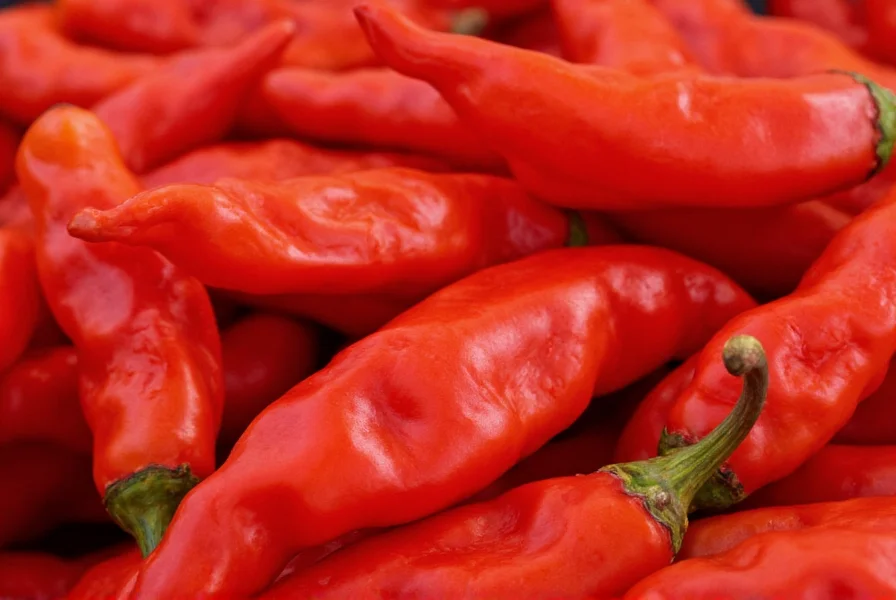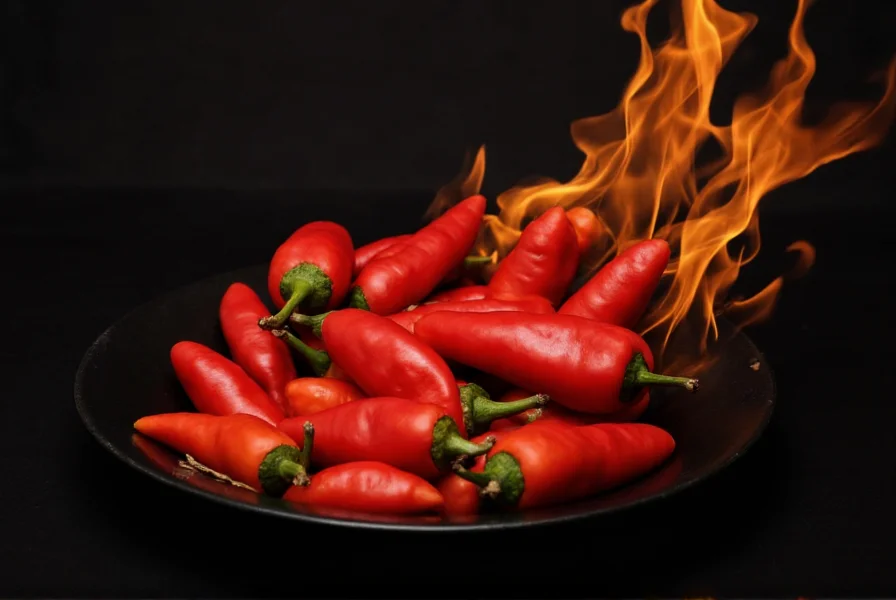The ghost pepper, scientifically known as Bhut jolokia, measures between 855,000 and 1,041,427 Scoville Heat Units (SHU), making it approximately 200-400 times hotter than a jalapeño pepper. Originating in Northeast India, this chili pepper held the Guinness World Record for world's hottest pepper from 2007 to 2011 before being surpassed by newer super-hot varieties.
Understanding the ghost pepper's extreme heat requires context. When the ghost pepper (Bhut jolokia) entered mainstream awareness, it revolutionized how we perceive chili heat. This small but formidable pepper packs a serious punch that demands respect from both culinary enthusiasts and casual food lovers alike. For those wondering how hot is a ghost pepper compared to everyday varieties, the difference is astronomical—while a jalapeño typically ranges from 2,500 to 8,000 SHU, the ghost pepper sits firmly in the super-hot category.
Measuring the Heat: Scoville Scale Explained
The Scoville scale remains the standard measurement for chili pepper heat. Developed by pharmacist Wilbur Scoville in 1912, this scale measures capsaicin concentration—the compound responsible for that burning sensation. The ghost pepper's official Scoville rating of 855,000 to 1,041,427 SHU places it in elite company among the world's hottest peppers.
| Pepper Variety | Scoville Heat Units | Heat Comparison |
|---|---|---|
| Ghost Pepper (Bhut jolokia) | 855,000-1,041,427 SHU | 200-400x hotter than jalapeño |
| Carolina Reaper | 1,400,000-2,200,000 SHU | 1.5-2x hotter than ghost pepper |
| Jalapeño | 2,500-8,000 SHU | Baseline for comparison |
| Habanero | 100,000-350,000 SHU | 1/3 to 1/8 the heat of ghost pepper |
Many people search for ghost pepper vs Carolina Reaper comparisons. While the Carolina Reaper currently holds the title of world's hottest pepper, the ghost pepper remains significantly hotter than most commercially available peppers. The heat difference between these super-hots isn't just academic—it affects how they're used in cooking and the safety precautions required.
Origin and Cultural Significance
The ghost pepper's name "Bhut" (meaning "ghost" in Assamese) reflects how its intense heat seems to sneak up on you. Native to the Northeast Indian states of Assam, Nagaland, and Manipur, this pepper has been used for centuries in local cuisine and even as a natural rodent deterrent. The name "jolokia" simply means "chili" in Assamese.
Contrary to popular belief, the ghost pepper wasn't created in a laboratory. It's a natural hybrid of Capsicum chinense and Capsicum frutescens species that evolved in the humid climate of Northeast India. The region's specific growing conditions contribute to the pepper's extraordinary heat level—a fact often overlooked when people ask what makes ghost peppers so hot.

Physical Characteristics and Flavor Profile
Beyond the burn, the ghost pepper offers a complex flavor profile that many chili enthusiasts appreciate. Before the intense heat hits (which can take 30-45 seconds to manifest), you'll notice:
- A distinct fruity, slightly sweet aroma
- Smoky undertones reminiscent of smoked paprika
- A floral quality that distinguishes it from other super-hots
- Initial flavor notes of apricot and apple
When evaluating what does a ghost pepper taste like, professional tasters describe a progression: first the fruitiness, then increasing heat that eventually overwhelms other flavors, followed by a lingering burn that can last up to 45 minutes. This delayed heat response is precisely why it earned the "ghost" moniker—the heat seems to appear out of nowhere.
Safety Considerations for Handling
Proper handling of ghost peppers is non-negotiable. The capsaicin concentration is high enough to cause chemical burns on skin and severe irritation if it contacts eyes or mucous membranes. Essential safety practices include:
- Always wearing nitrile gloves (latex won't protect you)
- Using eye protection when cutting or processing
- Working in well-ventilated areas to avoid inhaling capsaicin particles
- Never touching your face during handling
- Washing all surfaces and tools with soapy water afterward
For those experiencing ghost pepper burns on skin, immediate treatment involves washing with soap and water, then applying milk or a dairy-based product to neutralize the capsaicin. Avoid using water alone, as capsaicin is oil-soluble and water will spread the burn.
Culinary Applications and Usage Tips
Despite its fearsome reputation, the ghost pepper has legitimate culinary applications when used judiciously. Professional chefs recommend:
- Using no more than 1/4 to 1/2 of a pepper for a dish serving 4-6 people
- Removing seeds and membranes (where most capsaicin concentrates)
- Starting with tiny amounts and gradually increasing to desired heat level
- Pairing with dairy, sugar, or acidic ingredients to balance the heat
- Using in small quantities in sauces, chutneys, and meat rubs
For home cooks exploring ghost pepper culinary uses, remember that less is more. Many traditional Northeast Indian recipes use ghost peppers not for overwhelming heat but for their complex flavor profile, with heat being just one component of the overall taste experience.
Growing Ghost Peppers: What You Need to Know
Cultivating ghost peppers requires specific conditions that mimic their native environment. Successful growers note these critical factors:
- Long growing season (120-150 days from seed to harvest)
- Consistent temperatures between 75-90°F (24-32°C)
- High humidity levels (70% or higher)
- Well-draining, slightly acidic soil
- Ample sunlight (8-10 hours daily)
Many gardeners searching for ghost pepper growing conditions are surprised to learn that stress actually increases capsaicin production. Mild drought stress, temperature fluctuations, and slightly nutrient-deficient soil can all contribute to hotter peppers—a double-edged sword for growers.

Common Misconceptions About Ghost Peppers
Several myths persist about ghost peppers that deserve clarification:
- Myth: Ghost peppers can be fatal if consumed
Fact: While extremely uncomfortable, ghost pepper consumption isn't lethal to healthy adults - Myth: Milk completely neutralizes ghost pepper heat
Fact: Milk helps but won't eliminate the burn from significant exposure - Myth: All ghost peppers are equally hot
Fact: Heat varies significantly based on growing conditions and individual pods - Myth: The seeds contain most of the heat
Fact: The placenta (white membrane) holds the highest concentration of capsaicin
Responsible Consumption Guidelines
For those adventurous enough to try ghost peppers, following these guidelines ensures a safer experience:
- Start with minuscule amounts—less than 1/8 of a small pepper
- Have dairy products readily available (milk, yogurt, sour cream)
- Never consume on an empty stomach
- Avoid alcohol as it intensifies the burning sensation
- Don't attempt eating contests—this has led to hospitalizations
- People with gastrointestinal conditions should avoid entirely
Understanding ghost pepper health effects is crucial. While moderate consumption offers potential benefits like metabolism boost and pain relief, excessive intake can cause severe stomach pain, vomiting, and even temporary breathing difficulties in sensitive individuals.
Frequently Asked Questions
How long does ghost pepper burn last?
The intense burning sensation from a ghost pepper typically peaks within 2-5 minutes and can last 30-45 minutes in the mouth. Skin exposure may cause burning for several hours. Complete recovery usually occurs within 24 hours, though residual sensitivity can persist longer with significant exposure.
Can you grow ghost peppers indoors?
Yes, you can successfully grow ghost peppers indoors with proper conditions. You'll need a south-facing window or grow lights providing 8-10 hours of strong light daily, consistent temperatures between 75-90°F, high humidity (use a humidifier if necessary), and well-draining soil. Indoor plants typically produce fewer but equally hot peppers compared to outdoor cultivation in suitable climates.
What's the difference between ghost pepper and Scotch bonnet?
Ghost peppers (855,000-1,041,427 SHU) are significantly hotter than Scotch bonnets (100,000-350,000 SHU). Ghost peppers have a more floral, smoky flavor with delayed heat onset, while Scotch bonnets offer tropical fruit notes with immediate heat. Physically, ghost peppers are more wrinkled with a pointed tail, whereas Scotch bonnets are squatter with a bonnet-like shape. Both belong to the Capsicum chinense species but have distinct flavor profiles and heat characteristics.
How do you preserve ghost peppers for long-term use?
Ghost peppers can be preserved through several effective methods: drying (stringing whole peppers or using a dehydrator), freezing (whole or chopped in freezer bags), pickling (in vinegar solution), or making into sauces or powders. Dried ghost peppers retain potency for 1-2 years when stored in airtight containers away from light. Frozen peppers maintain quality for 6-12 months. Always label preserved ghost peppers clearly and handle with gloves during preparation.
Are there any health benefits to consuming ghost peppers?
Ghost peppers contain capsaicin, which has documented health benefits including pain relief (used in topical analgesics), metabolism boost, anti-inflammatory properties, and potential cardiovascular benefits. They're also rich in vitamins A and C. However, these benefits come with significant caveats—consumption should be moderate, and people with gastrointestinal conditions, ulcers, or certain medications should avoid them. The health benefits don't justify reckless consumption given the extreme heat levels.











 浙公网安备
33010002000092号
浙公网安备
33010002000092号 浙B2-20120091-4
浙B2-20120091-4